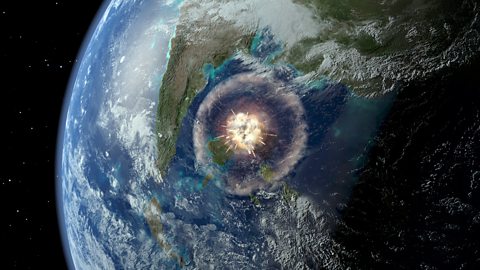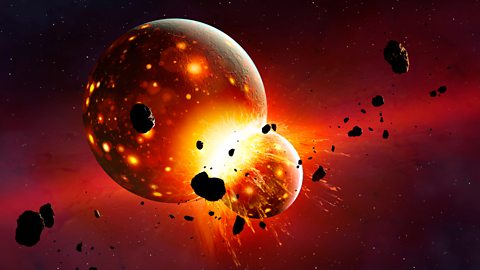How did we get here?
How have we ended up as the most advanced species on a small blue-green planet, orbiting a seemingly insignificant star, in one of the hundred billion galaxies in the Universe?
Science has found some extraordinary answers to this question. Looking back through time, it appears that our existence depends on an apparently unlikely sequence of cosmic moments.
2000 AD
The International Space Station - a triumph of human intelligence
In November 2000, the first astronauts arrived on the International Space Station. Since then, we have had a permanently manned base among the stars.
We can venture into space because our species has built up a knowledge of physics and engineering, generation after generation, to the point where we can launch a rocket from Earth's surface that travels at a speed of seven miles every second. That makes us the only creature on Earth - possibly the only creature in our galaxy, or even our Universe – to have left its home world. So how did we become such a unique animal?
Brian experiences what life in space is like, at the Yuri Gagarin Cosmonaut Training Centre in Russia. Clip from Human Universe (BBC Two)
1 million years ago
Did changes in the Earth's orbit make us intelligent?
Human intelligence was born in the Great Rift Valley of East Africa, as our ape ancestors evolved increasingly bigger brains.
That may only have happened because of the Sun, Moon, and other planets in our Solar System. Their gravity makes the Earth's orbit change how elliptical it is, over thousands of years. That in turn affects our planet's climate. And looking at the fossil record, our ancestors' increases in brain size happened when the Earth's orbit was at its most elliptical, a time of rapid and violent climate change, when adaptability and intelligence would have been a huge evolutionary advantage.
Brian explores how increases in the skull sizes of our ancestors may have been a response to climate change. Clip from Human Universe (BBC Two)

65 million years ago
A cosmic disaster wipes out the dinosaurs
But our ape ancestors might never even have existed. 65 million years ago, dinosaurs dominated the Earth, as they had done for over 160 million years.
Then an asteroid, almost six miles across, collided with the Earth. The impact was the equivalent of over a billion Hiroshima bombs, and blasted rock and dust into the atmosphere, shrouding the planet in darkness. Over half of all life on Earth was wiped out, including most of the dinosaurs. Without this, the small shrew-like mammals, which were the ancestors of the Rift Valley apes and all humans, may never have flourished. The world might still be dominated by dinosaurs and their descendants.

2.4 billion years ago
A new type of bacteria creates oxygen
Life existed on Earth for billions of years with almost no oxygen in the air. Most bacteria fed off carbon dioxide and other gases, like methane.
Then a new type of bacteria evolved. These cyanobacteria created energy in a new way: photosynthesis, using sunlight to split water. Oxygen was just a waste product of this process, but over time, levels in the air built up to what we breathe today. If this hadn't happened, and Earth had stayed shrouded in carbon dioxide and methane, animal life could never have evolved on our planet.
Brian on how the oxygen we depend on today was originally generated by ancient bacteria. Clip from Wonders of Life (BBC Two)
2.7 billion years ago
A chance collision creates complex life
For a billion years, the only life on Earth was single cells. Then something happened which created the template for all complex life.
Two single cells merged together. They got inside each other and, instead of dying, formed a kind of hybrid, which survived and proliferated. And because every animal and plant today shares the same basic building block – the same type of cell structure – we are very confident that this only happened once, somewhere in the oceans of the primordial Earth. Biologists call this one-time event ‘the Fateful Encounter’, and it suggests that complex life requires a good dose of random chance.
Prof Brian Cox explores the first moment a two single cells merged together
3.8 billion years ago
Complex molecules combine to create life
How unlikely was the moment when life first began on Earth? That remains one of the greatest mysteries about the origins of human existence.
We still don't know how life arose, but it may well have happened at hydrothermal vents - underwater hot springs dotted across the ocean floor. They churned out a potent mix of chemicals and energy, that may have combined to create the first life. Whatever the truth, many scientists believe that with the right conditions, the chances of life arising are surprisingly high. But if those conditions had not existed on Earth, our planet today would be a watery soup of complex chemicals, but no more.
Brian explains how an energy source called a proton gradient may have helped life form at hot underwater vents. Clip from Wonders of Life (BBC Two)
4 billion years ago
Life-giving water arrives from space
For life to begin and thrive, it needed water. But the young Earth was a ball of molten rock, and any surface water quickly evaporated into space.
So where did water come from? Some was probably trapped deep in the Earth as the planet formed, saving it from evaporation. It could then be released by erupting volcanoes, as the Earth cooled. And some came from beyond our planet, from icy comets crashing into Earth. Without this water from beneath the Earth's crust and from space, Earth would have been a lifeless ball of rock.
Brian reveals how icy comets may have been the source of Earth’s water. Clip from Wonders of Life (BBC Two)

4.5 billion years ago
Earth gets a moon, but is almost destroyed in the process
The Moon's gravity changes the way the Earth moves through space. That affects our planet's climate, helping to shape the evolution of life.
But Earth was born without a Moon – and was almost destroyed in its creation. 4.5 billion years ago, another young planet in the early Solar System crashed into Earth. Both were almost blasted to pieces in the collision. Earth survived. The other young planet did not. A huge amount of rocky debris was thrown into space. Gravity made this debris coalesce into the Moon. The collision also released iron from the Earth’s core, contributing to the chemical cocktail from which life would emerge.

4.6 billion years ago
A dying star provides the spark to start our Sun
There are billions of solar systems in our galaxy. But the one we call home might never have come into being, without another cosmic accident.
It was probably the death of another star, born billions of years before our own Sun, that created the Solar System. One theory is that this star exploded, igniting inert gas in a cloud of cosmic dust. Our Sun formed from this, along with a spinning disc of matter that became the planets. Without this, the cloud that gave birth to the matter in our Solar System, including our Earth, and us, might have drifted until it dissipated over many billions of years.
Brian explores how our Solar System was created from a nebula - a giant cloud of gas and dust. Clip from Wonders of the Solar System (BBC Two)
13.8 billion years ago
The Big Bang: the creation of the perfect universe for life to evolve in
The Big Bang, the moment when the Universe came into being, seems like the greatest chance event in the story of human existence.
At the Big Bang, the ingredients of the Universe were created - a set of numbers, called constants of nature, such as the speed of light, the strength of gravity, and the number of dimensions of space. Remarkably, these numbers seem to be just right for our Universe to contain life. If they were just a little bit different, it might quickly collapse, or not contain the right chemical elements, or stars and planets might not form. So is there a reason that we seem to have won the cosmic lottery?
How did the early Universe form after the Big Bang? Clip from Wonders of the Universe (BBC Two)
Before time…
The multiverse: was human existence inevitable?
The most popular models for the origin of our Universe suggest that it is one of a countless, even infinite, number of universes.
These models predict that each of these universes has different numbers for the constants of nature: stronger gravity, or weaker gravity; slower light, or faster light. If the theory is true, we shouldn't be surprised to live in the perfect universe. Just like the lottery, among all the universes that exist, there would be a winning ticket: a universe with exactly the right constants of nature to create the conditions for life. A human universe.
Brian explores the theory that our Universe may be just one of many in a larger multiverse